|
This review page is supported in part by the sponsor whose ad is displayed above
|
|||||||||||||
 |
|||||||||||||
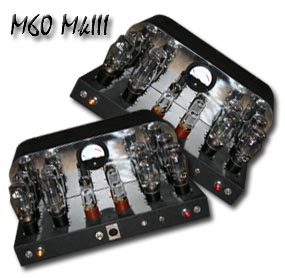 |
|||||||||||||
| Considering the OTL competition, the oldest house in the US is Atma-Sphere. They offer the M60 MkIII 60-watt monos at $5,950/pr and the 140-watt MA-1 MkIII monos at $13,600/pr. Were the Navisons sold through dealers and a separate US distributor supplied those dealers, pricing would be $13,700/pr. That's indeed what preliminary talks | |||||||||||||
 |
|||||||||||||
| with prospective distributors at CES 2007 had set. Faced with that reality, Navison decided to act as their own US distributor. They now sell their massive amplifiers for $8,900/pr through a developing dealer network. Based on power rating, that makes them competitive. The | |||||||||||||
| Joule Electra VZN-100 MkIII Marquis monos for example carry a tag of $13,300/pr. Navison's cosmetics too make them a valid alternative to the vintage black'n'chrome threads of Atma-Sphere and the modern lacquer chic of Joule Electra. This brief survey suggests that the Navison amps are positioned properly to bode well for success if performance followed suit. As Big Tobacco's chief lobbyist put it to his spin doctors in the comedy Thanks for Smoking: "Cigarettes are cool. They're available. They're addictive. Our job is already almost done for us." In other words, all you need is give people a hit and they're hopelessly hooked. True here as well? |
|||||||||||||
 |
|||||||||||||
As the photo with the Navison ladies drives home if it hadn't registered yet, these amplifiers are no cool pack of Virginia Slims. They're huge. And they run hot. They won't fit any normal rack, plus the heat generated is best left to rise unrestrained in the first place. These monos are styled as showcase trophies. They're to be displayed accordingly. Prospective buyers might first seat them on the floor but will probably soon opt to elevate them on custom amp stands as Navison did at the Las Vegas CES 2007 above. That at least would befit their stature. As temporary loaners, I couldn't take things that far. I had to position them right on the carpet. We have neither kids nor dogs and our feline Suki is smart enough to give a wide berth to anything hot and glowing in the audio den. Like cage fighters, the amps arrived securely ensconced after their long trip around the world, first from Vietnam to the US, then from LAX to JFK to LKA via Royal Jordanian airlines. Packaging was first rate and the goods arrived unharmed. |
|||||||||||||
 |
|||||||||||||
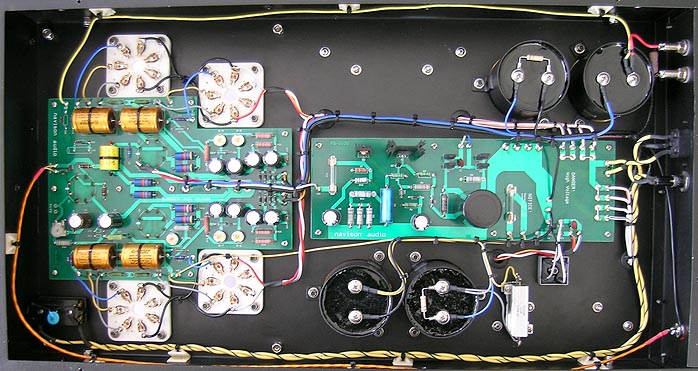 |
|||||||||||||
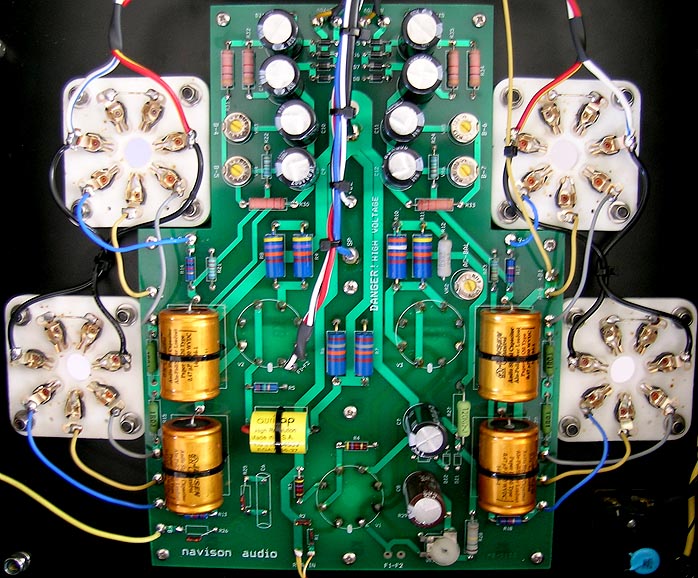 |
|||||||||||||
The innards proved just as substantial and deliberate, with German M-Caps, Danish Jensen PIOs and American Auricaps in evidence, never mind those four huge capacitors poking through the chassis to show up atop as matched pairs, one pair before one transformer, the other tucked behind the second. |
|||||||||||||
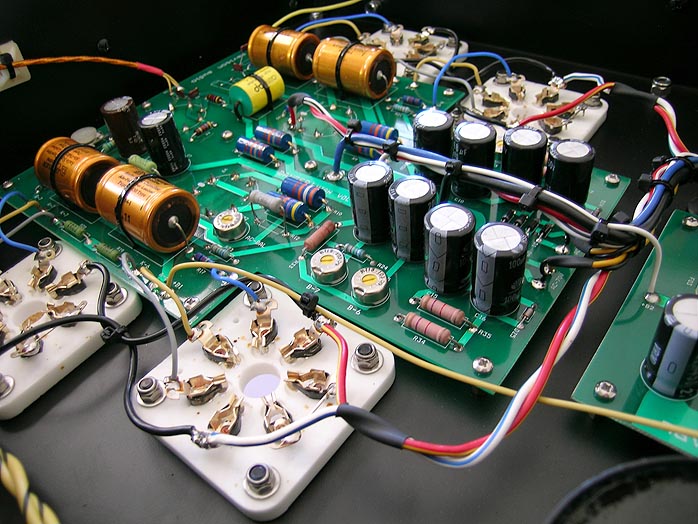 |
|||||||||||||
 |
|||||||||||||
 |
|||||||||||||
Taking its cues from the fascia with its deeply engraved brand name in relief, the pale champagne dress cover for the valve deck sports luxurious engravings for the model name, for each tube socket and for the two-pole power toggle. Unfortunately, the tag line reads "triode output tube manual amplifier" instead of "monaural". As I learned, the intended meaning in fact was "handcrafted". Put it down to the language barrier. |
|||||||||||||
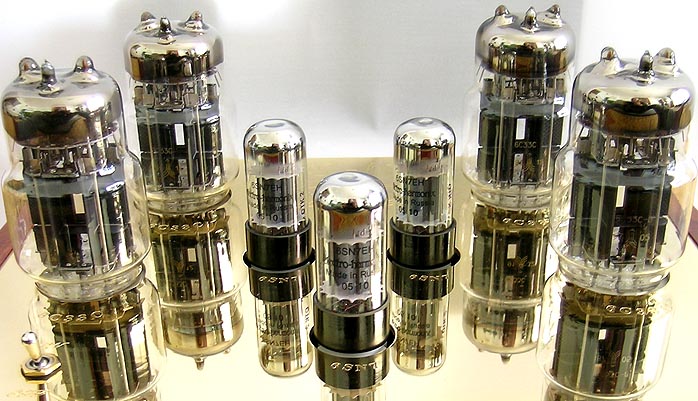 |
|||||||||||||
The back sports the expected pair of --silver -- binding posts, a single-ended input, the mains fuse and a power inlet. |
|||||||||||||
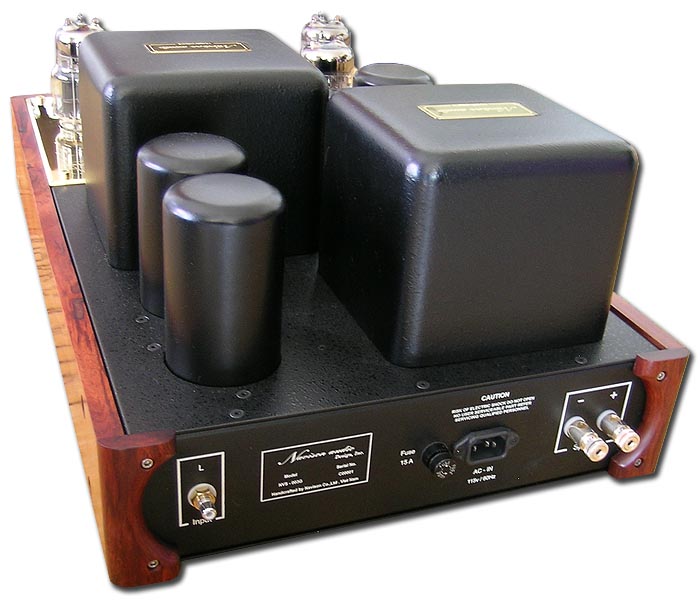 |
|||||||||||||
| The Baryan Kingswood and champagne metal accents are curiously mismatched by the SE-MkII remote-controlled preamp. Unlike the SE-MkI which does match, the MkII sports a pale silver face. That is offset by two beveled wings of a very different burled wood species. And the remote is champagne. For a company as fastidiously concerned with appearance, these trim choices seem curious. And how about the odd-ball sizing? At least Linn and Naim are smaller than standard. They fit the usual audio furniture whereas the Navison preamp's unfriendly 21.85" wing span won't fit into any standard rack. It thus enforces placement on the top shelf. A bit limiting perhaps for any latecomer trying to win quick friends? The focus on fine woods works just as well in standard width where it adds freedom of placement in the kind of standard audio furniture many will already own and be committed to. |
|||||||||||||
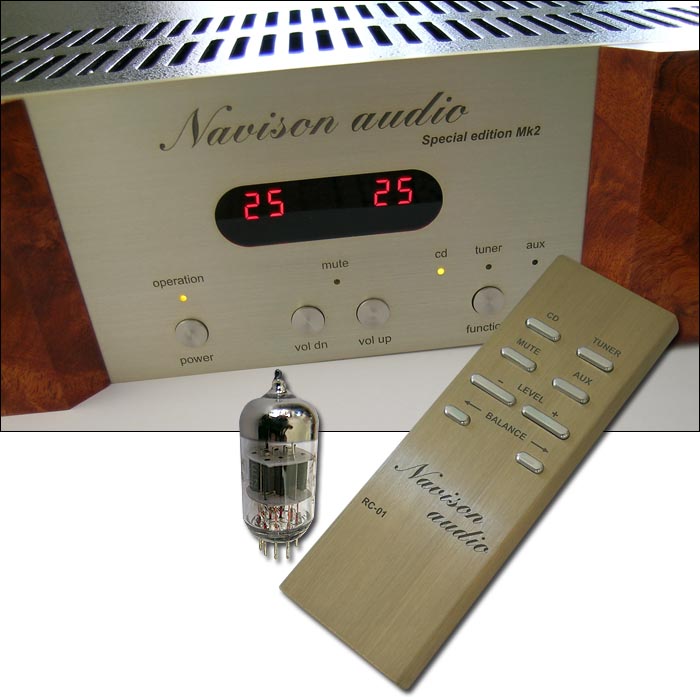 |
|||||||||||||
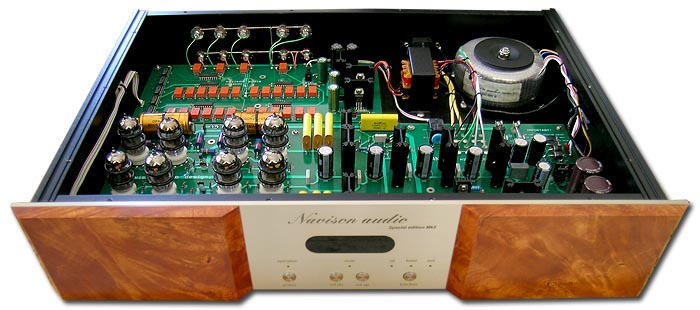 |
|||||||||||||
 |
A worrisome rattle inside the dead remote had me crack it open by removing two hex nuts. The battery holder exhibited a bit of both lateral play and head room to move about and clank. A sliver of foam would remedy this instantly. All the vital functions except for balance are duplicated on the MkII front. Even if one misplaced the remote, wore out the batteries or was shipped dead ones, the MkII would still function. The toroidal mains transformer inside proved to have a bit of play as well, making a small mechanical sound when the preamp was lifted. Its lock-washer'd center bolt turned out to be readily turnable by hand. This of course also twirled the hidden bolt head underneath so I couldn't tighten it properly. Each of the eight 6H1-EB valves arrived installed by the way and fitted with twin rubber lookalike rings to combat microphony. |
||||||||||||
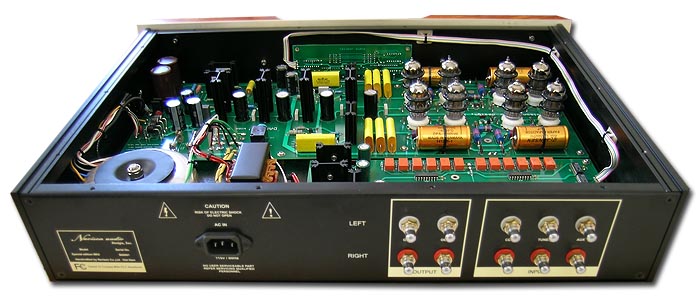 |
|||||||||||||
| The owner's manual advises that the actual line voltage should be within +5/-10% of the nominal rated voltage. Therein lies a rub. Depending on time and day, I've measured up to 135V on my 120Hz feed (in Cyprus, it's not just the weather that's hot). Some transformers are sensitive to over-voltages and retaliate with hum. In my experience thus far, most take it in stride and remain mum. Navison's went off like greased lightning. The preamp was humming audibly, the OTLs insanely so. In fact, they distinguished themselves as the mechanically noisiest amps I've ever encountered - and by a very large margin. The premium Tango iron used appears narrowly specified and vehemently intolerant of AC voltages outside its window. Exceed that window and the amps become categorically unusable. The only solution then is a line voltage regulator like a PS Audio PowerPlant which must be capable in this instance of supplying the 250-650 watts of power demand per amp. Don't mistake this for electrical noise. Even over 101dB sensitive speakers like my Zu Definition Pros, the 003-Gs are dead quiet. Ear on drivers, the amps may as well not be on. That is impressive. |
|||||||||||||
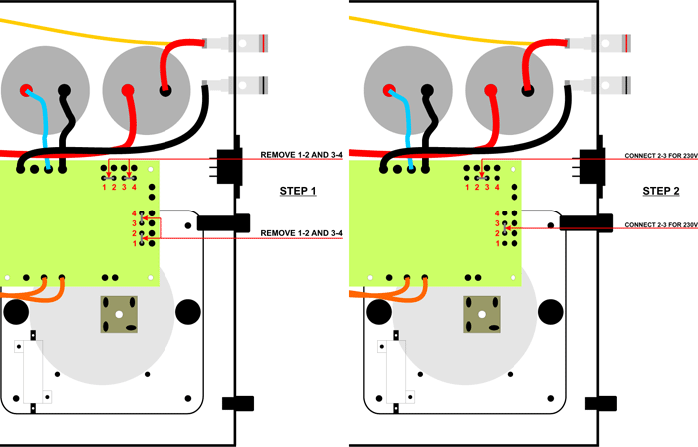 |
|||||||||||||
Ben Nguyen from Navison wanted me to rewire the amps for 230V. This involves resoldering jumpers as shown above. Afterwards, the hum level dropped but still was higher than normal. Considering that a €1,680 50-watt Melody SP-9, on the same line, is mechanically dead quiet outfitted with Chinese iron, color me less than impressed with the high-brow Tango trannies. Apparently Navison has sold 20 pairs of NVS-003Gs to date. They've never experienced this before. Given the class for which these amps are designed and priced, I would suggest adoption of transformers with a broader window of acceptable under/over voltages to eliminate the potential need for a line voltage stabilizer. Ben agrees and has already contacted Tango in Japan to see whether the performance specifications for these transformers can be expanded to include wonky power utility scenarios such as mine. |
|||||||||||||
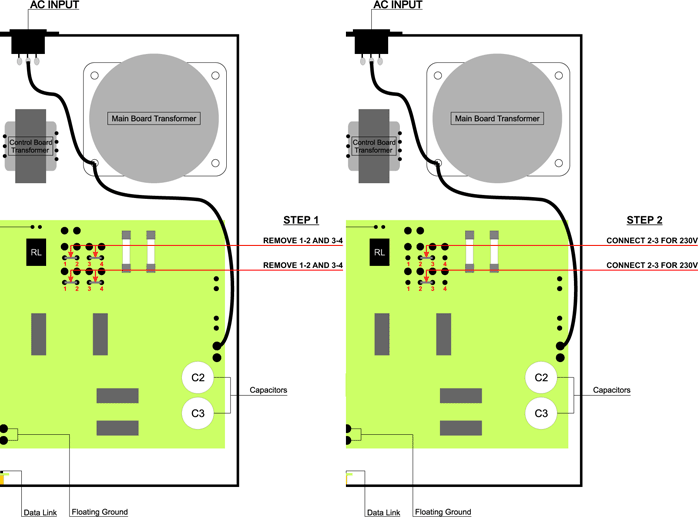 |
|||||||||||||
I likewise rewired the preamp. It reacted equivalently by lowering its hum level in 230V mode straight into the wall (rather than through a 1.5KV step-down transformer in 120V mode as delivered). Having exhibited lower noise than the monos to begin with, this now made the preamp normal, i.e. guilty only of very subdued mechanical hum. |
|||||||||||||
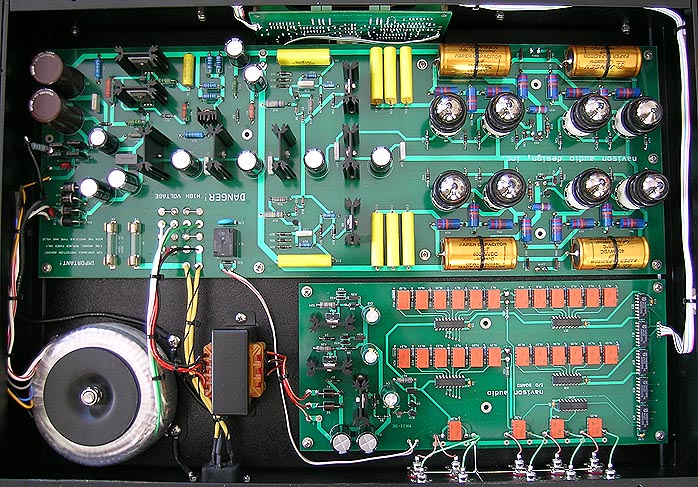 |
|||||||||||||
The SE-MkII inverts phase. It also undergoes a prolonged 90-second turn-on cycle during which its outputs are muted, then the level automatically sets itself to 25. |
|||||||||||||
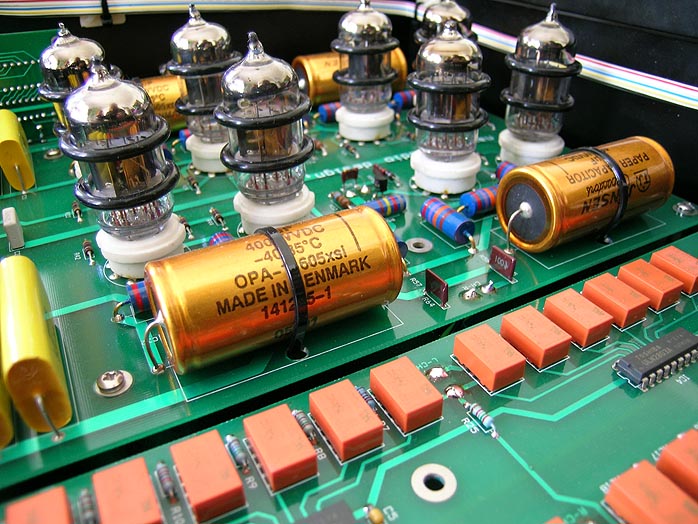 |
|||||||||||||
Microprocessor controlled, the discrete resistor ladder attenuator operates in 100 steps of approximately 0.7dB steps for a maximum output of 15V at 99, with 24.5dB of gain. The inputs are switched by relays. Input impedance is ca. 50K and output impedance lower than 1.8K. |
|||||||||||||
 |
|||||||||||||
|
Cosmetically, the NVS-003Gs somewhat echo Cary's massive CAD 805s while the SE-MkII could be viewed as a bit CJ-ish, minus the wood of course.
Wrapping up first inspections, a few items about the preamp are curious. These are its excess width; its color scheme compared to the amps; and it being limited to three inputs while asking for a not insubstantial $4,900. Navison is adamant that despite the relay switching chosen, additional inputs would negatively impact sonics. The only cosmetic blemish with the amps is the misspelled engraving. Something else worth mentioning is that despite their boffo size, the transformer cans aren't potted and in fact ring freely when tapped. Considering the amps' non-crammed innards, some will also question whether these monos really have to be this huge and hence hard to place. "Bigger is better" is simply so passé in today's climate of flat-screen televisions and small speakers. Whether Navison bucks trends deliberately or for lack of a closer understanding of Western markets isn't clear. In my book, having to overcome upfront buyer objections for lack of features or limited placement options is the most likely outcome regardless. If so, that's a curious strategy for any new kid on the block to adopt deliberately and with pride. In talking with Ben Nguyen, I learned that he primarily listens to Classical and Jazz and did in fact design his NVS-211 monos which John Potis reviewed accordingly. He is convinced that these music types are best served by those amps. When I interjected that superior components will reproduce all music equally well regardless of chosen output devices, I could tell he disagreed. Should the upcoming listening evaluations bear out that these monos too favor his kind of music over what I listen to most of the time, then we'd know exactly why.  |
|||||||||||||
 |
In a subsequent e-mail, Nguyen informed us that the SE-MkII preamp is now also available in matching livery, i.e. with Baryan Kingswood wings and champagne metalwork. More importantly, Tango in Japan was able to expand the acceptability window of under/overvoltages for their transformers which should eliminate the mechanical hum issues I encountered. Such responsive action to isolated feedback -- let's remember that no prior Navison customers reported any noise problems -- is impressive and a real feather in their cap. On a serious downside, one amp's power transformer, after an insignificant duty cycle, literally went up in acrid smoke. This assignment was turning into a manufacturer's nightmare and struggle to prove that there was nothing wrong with the ultra-expensive transformers in their amps. Navison explained that prolonged exposure to overvoltages had weakened the transformers. What they didn't know was how little time the amps had been powered up and running before the power transformer quit. Considering the monos' weight and travel distance, I really felt bad for Navison yet back to the US the pair would have to go for inspection and repair. Since the firm had elected to also ship the preamp, I'd get started with that. |
||||||||||||
| Or so I thought. Except that the | |||||||||||||
| preamp, though continuing to respond to the remote control, now faded out after one CD and thereafter stopped to pass signal again. It had also gotten very hot and started to smell, suggesting that the circuit itself had gone into protection because the wall voltage exceeded what the transformer accepted. It was at this juncture that I opted out. Cyprus power and Navison didn't see eye to eye. Some things are simply not meant to be. So it was with this review assignment of beautifully built electronics from a hopeful new company. What softens the blow is John Potis' prior writeup of their NVS-211s and matching SE MkI in these pages. That review went without an electrical hitch or mishap to suggest that my location was unsuitable to render this more than a tantalizing but indefinite preview. | |||||||||||||
 |
|||||||||||||
 |
|||||||||||||
|
Manufacturer's website
|
|||||||||||||
 |
|||||||||||||